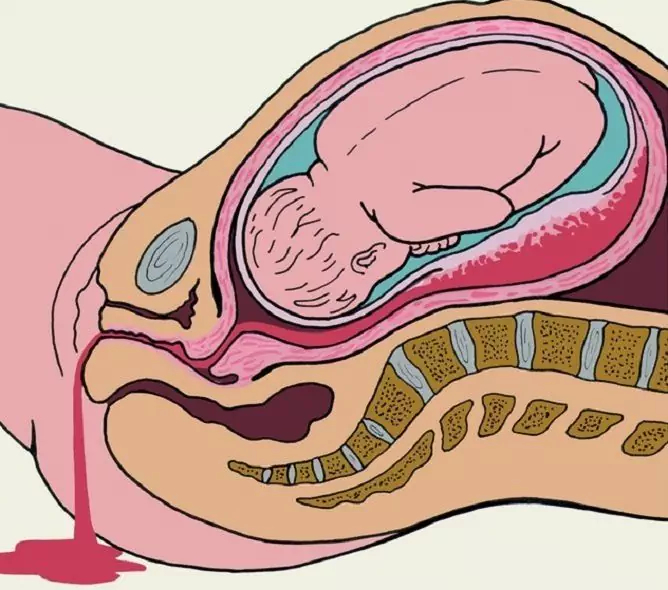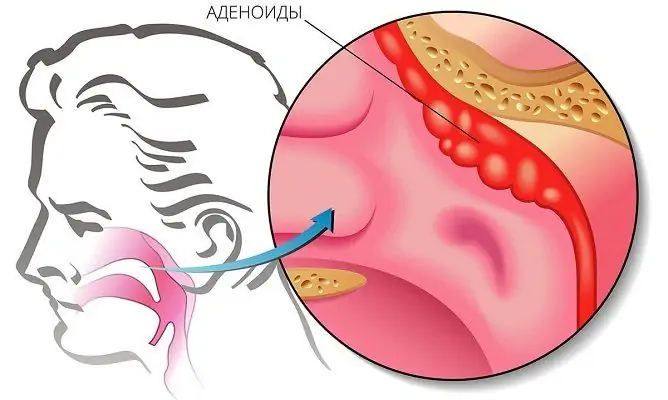- Author Rachel Wainwright [email protected].
- Public 2023-12-15 07:39.
- Last modified 2025-11-02 20:14.
Atrophic colpitis
The content of the article:
- Causes and risk factors
- Symptoms of atrophic colpitis
- Diagnostics
- Treatment of atrophic colpitis
- Potential consequences and complications
- Forecast
- Prevention
Atrophic colpitis (senile or senile colpitis, estrogen-deficient colpitis) is a reaction of the cells of the vaginal epithelium to a decrease in estrogen in a woman's body and is clinically manifested by a recurrent inflammatory process, itching, dryness, dyspareunia.

Source: takprosto.cc
Atrophic colpitis occurs in 80% of postmenopausal women in the absence of hormone replacement therapy. The disease manifests itself approximately 5-6 years after the last menstruation.
Causes and risk factors
The mucous membrane of the vagina is formed by squamous stratified epithelium. Its main function is to protect the female genitals from infectious agents. The upper cells are constantly renewed, and together with the dead cells, pathogenic microbes and toxins are removed from the vagina with the help of mucous secretions. In addition, the epithelium ensures the constancy of the acid-base environment of the vagina, the pH of which is normally 3.8-4.5.
The vaginal microflora is 98% represented by lactobacilli (Dederlein sticks) - gram-positive bacteria that convert carbohydrates into lactic acid. The acidic environment of the vagina prevents the activation of conditionally pathogenic and prevents the penetration of pathogenic microflora. Lactic acid bacteria feed on glycogen, which in a sufficiently large amount contains dead cells of the upper layer of the vaginal epithelium.
With prolonged estrogen deficiency, the cyclic renewal of the vaginal epithelium almost completely stops, the desquamation of its cells decreases. As a result, the nutrient medium for lactobacilli is depleted, which causes a sharp decrease in their number. This process is accompanied by alkalinization of the vaginal environment, activation of opportunistic microflora, narrowing of the vaginal lumen, mainly in the upper section. All this contributes to the development of the inflammatory process, that is, colpitis.
Violation of the process of proliferation of the vaginal epithelium and a decrease in the secretion of its glands lead to thinning and dryness of the mucous membrane, its increased vulnerability.
Deficiency of estrogen, which triggers the development of a pathological process in the vaginal mucosa, can be physiological or artificial.

The causes of estrogen deficiency are:
- postmenopausal period - the ovaries stop functioning and produce estrogen;
- postpartum period - the restoration of hormonal levels after childbirth sometimes requires a long time. If a woman is breastfeeding, due to the increased production of prolactin by the pituitary gland, estrogen synthesis is suppressed;
- hormonal dysfunction - strong emotional upheavals, endocrine pathology (diseases of the thyroid gland, adrenal glands, diabetes mellitus) disrupt the overall hormonal balance of the body, contributing to the development of hypoestrogenism;
- oophorectomy - after surgical removal of the ovaries, the synthesis of estrogen in the woman's body does not occur;
- radiation therapy of the pelvic organs - irradiation of the ovaries becomes the reason for the suppression of their functions;
- immunodeficiency - suppression of the functions of the immune system has a negative effect on all organs and systems, including the female gonads. This is confirmed by the fact that most women with HIV infection in the AIDS stage have symptoms of atrophic colpitis.
Predisposing factors:
- non-observance of the rules of intimate hygiene;
- unprotected promiscuous intercourse with different partners;
- the use of products with a significant content of aromatic substances for intimate hygiene;
- wearing underwear made of synthetic fabrics with poor air permeability (insufficient air supply to the vaginal mucosa creates optimal conditions for the development of anaerobic microflora);
- lack of fermented milk products in the diet;
- chronic gynecological and / or somatic diseases;
- earlier onset of menopause.
Symptoms of atrophic colpitis
The first signs of the disease usually appear 5-6 years after the last menstruation. Atrophic colpitis is characterized by a sluggish, low-symptom course. With the activation of opportunistic flora or the addition of a secondary infection, which is largely facilitated by the easy vulnerability of the vaginal mucosa, the severity of clinical manifestations increases.
The main symptoms of atrophic colpitis:
- vaginal discomfort - patients complain of a feeling of tightness, vaginal dryness, burning or itching;
- dyspareunia - thinning of the vaginal mucosa, a decrease in secretion by the glands, damage to nerve endings cause pain during intercourse or immediately after it;
- frequent urination - atrophic colpitis is always accompanied by a weakening of the tone of the muscles and ligaments of the small pelvis, thinning of the walls of the bladder, as a result of which the number of urination increases, and further urinary incontinence develops;
- prolapse of the walls of the vagina, uterus and bladder - associated with a weakening of the tone of the muscles of the pelvic floor.
Vaginal discharge is usually mild, slimy, or watery. When an infection is attached, the nature of the discharge changes in accordance with the type of infectious agent. They can become cheesy (fungal infection), foamy (bacterial vaginosis), greenish (trichomoniasis).
After a gynecological examination, douching, sexual intercourse, an admixture of blood often appears in the discharge, which is explained by mild trauma to the vaginal mucosa. It should be borne in mind that the appearance of bloody discharge in postmenopausal women may also indicate the development of malignant neoplasms of the genital organs. Therefore, with the regular appearance of blood in the vaginal discharge, a woman must necessarily be examined by a gynecologist.
Diagnostics
The main methods for diagnosing atrophic colpitis:
- gynecological examination;
- cytological and microscopic examination of vaginal secretions;
- extended colposcopy;
- determination of the pH of the vagina.
When viewed in the mirrors, the atrophied mucous membrane of the vagina has a pale pink color, microcracks and punctate hemorrhages are present. It bleeds easily when touched by mirrors. When a secondary infection is attached, the mucous membrane is swollen and hyperemic, purulent discharge or a grayish plaque is found on it. The ratio of the length of the cervix to the body of the uterus becomes 2 to 1, which is typical for childhood. Degenerative processes in the advanced stage of atrophic colpitis lead to partial or complete fusion of the vaginal vaults.
Determination of the pH of the vagina is carried out using indicator strips (with atrophic colpitis, its index is 5.5-7).
Schiller's test gives a slight uneven coloration.
Cytological examination of the smear reveals the predominance of cells of the basal and parabasal layers.
With smear microscopy, a significant decrease in the number of Dederlein's rods, the presence of opportunistic microflora, and an increase in the number of leukocytes are determined.
If you suspect the specific nature of colpitis (herpetic, gonorrheal, Trichomonas), a study of vaginal discharge by PCR is shown, consultation of a venereologist may be required.
Treatment of atrophic colpitis
The main goal of the treatment of atrophic colpitis is to restore normal metabolic processes in the epithelial cells of the vagina, which helps to restore the functions of the mucous membrane, eliminates inflammation and prevents its recurrence.

Source: depositphotos.com
Shown is hormone replacement therapy with estrogen preparations. Systemic estrogen therapy is carried out for a long time, over several years. If the woman's uterus has not been removed, progesterone preparations are additionally prescribed in monthly courses of 10 days.
Local therapy is carried out with a vaginal cream with conjugated estrogens.
In the treatment of atrophic colpitis, phytotherapy is used - prescribe ingestion of decoctions and infusions of herbs rich in phytoestrogens (sage, raspberries, linden blossom).
When a secondary infection is attached, sulfa drugs and antibiotics are indicated, taking into account the sensitivity of the pathogen to them.
The development of urinary incontinence is an indication for the periodic use of uroseptics in order to prevent ascending urinary tract infection.
To assess the effectiveness of the treatment of atrophic colpitis, vaginal pH, cytological and microscopic examination, dynamic colposcopy are periodically carried out.
Contraindications to estrogen therapy are:
- mammary cancer;
- ovarian tumors;
- endometrial cancer;
- vaginal bleeding of unexplained etiology;
- pregnancy;
- ischemic heart disease (angina pectoris, myocardial infarction, atherosclerotic cardiosclerosis);
- liver disease;
- increased blood clotting;
- a history of venous or arterial thromboembolism.
If there are contraindications to hormone replacement therapy, douching of the vagina with infusions of herbs with anti-inflammatory, antiseptic and reparative properties (flowers of chamomile, calendula, St. John's wort) is prescribed.
Potential consequences and complications
Treatment of atrophic colpitis with estrogens may be accompanied by side effects, including headache, nausea, uterine bleeding, endometrial hyperplasia, endometrial tumors, thrombophlebitis.
When carrying out hormone replacement therapy, patients with concomitant pathology (mastopathy, epilepsy, arterial hypertension, diabetes mellitus) require special attention.
Forecast
The prognosis for life is favorable. Frequent relapses of the disease significantly worsen the quality of life of patients.
Prevention
In order to prevent atrophic colpitis after menopause, hormone replacement therapy is prescribed, which not only prevents the development of atrophic processes in the vaginal mucosa, but also reduces the pathological manifestations of menopause, reduces the risk of cardiovascular diseases and osteoporosis.

For the prevention of the early onset of menopause and, accordingly, the early termination of estrogen production, it is recommended:
- balanced diet;
- to give up smoking;
- observance of the regime of alternation of work and rest;
- dosed regular physical activity;
- regular walks in the fresh air;
- wearing underwear made from natural fabrics;
- careful observance of intimate hygiene;
- regular sex life with a regular partner.
YouTube video related to the article:

Elena Minkina Doctor anesthesiologist-resuscitator About the author
Education: graduated from the Tashkent State Medical Institute, specializing in general medicine in 1991. Repeatedly passed refresher courses.
Work experience: anesthesiologist-resuscitator of the city maternity complex, resuscitator of the hemodialysis department.
The information is generalized and provided for informational purposes only. At the first sign of illness, see your doctor. Self-medication is hazardous to health!






